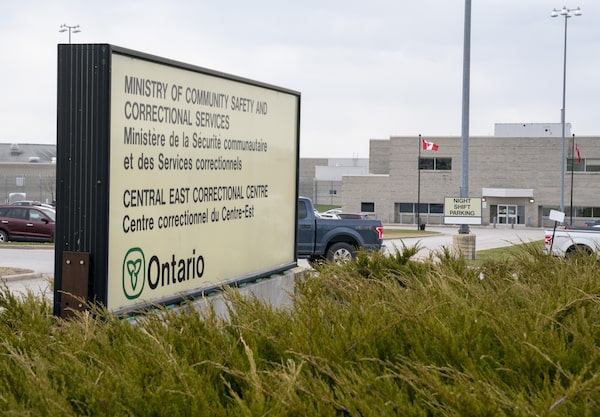
In Ontario, the average daily percentage of remand inmates for 2022-23 was 80.4 per cent. Another 3.7 per cent were in immigration detention or police custody – leaving the number of those found guilty and sentenced at just 15.9 per cent.Frank Gunn/The Canadian Press
As many as four in every five inmates in some provinces are being held in jail without being convicted of the offence they are accused of, a Globe and Mail survey has found.
The numbers, which have risen sharply over the past five years, raise questions about whether Canada’s bail system keeps too many people in custody, even as it has come under fire over the release of accused people who went on to be charged in cases of extreme, sometimes random violence.
Critics in the legal community say the high percentages reflect a clogged system, and that proposed legislation aimed at preventing the release of high-risk individuals will only add to the numbers of the presumptively innocent in jail.
Queen’s University academic Nicole Myers, co-author of an influential 2014 report on remand, called The Globe’s data “horrifying.”
“To me, it flies in the face of the way our system is supposed to operate,” she said in an interview. Even those who are eventually found guilty may have served most or all of their time already, and in remand, little rehabilitative programming is available, she said.
OPINION: The crisis in Canada’s bail system is not one of laxity
The Globe asked provincial governments for the numbers of people in custody and the percentage on remand in each of the past five years. Seven provinces gave partial or complete answers.
In Alberta, on Sept. 21, 77 per cent of inmates in provincial custody were not convicted or sentenced. These are known as remand inmates – the system’s temporary detainees. In British Columbia, from Sept. 1-18, the average daily proportion not convicted and sentenced was 74 per cent. Five years ago, the average daily proportion on remand was 63 per cent in each of the two provinces.
Ontario’s results were more stark. The average daily percentage of remand inmates for 2022-23 was 80.4 per cent. Another 3.7 per cent were in immigration detention or police custody – leaving the number of those found guilty and sentenced at just 15.9 per cent. Four years ago, the average daily number on remand was 70.9 per cent.
The data do not break down why so many inmates are on remand, nor does it make clear how many of those on remand are there because bail was denied to them.
The question of why the jails are filled with those who are presumed innocent, and what should be done about it, has received little public attention. Instead, the focus has been on stopping repeat, violent offenders from being released on new charges.
The numbers of legally innocent in jail have grown since Prof. Myers’s 2014 report, when the rate was 55 per cent. (In the early 1990s, the percentage of inmates in jail on remand hovered between 23 and 30 per cent, and passed 50 per cent in 2005.)
Legal observers say the reasons for the increasing rates are complex. They include jammed bail courts, which often send accused persons back to their cells at the end of a day without a bail decision being made. Adjournments of bail hearings may last days or weeks. And court delays, which have been growing worse since the pandemic ended, mean that if inmates are not released on bail, their trials could be months or years away, causing a larger buildup of the remand population.
Prof. Myers said many accused persons are in limbo, trying to develop release plans often involving sureties or supervisors to obtain the consent of prosecutors before making their request before a justice of the peace.
EDITORIAL: How to get tougher on bail without violating the Charter of Rights
EDITORIAL: The flip side of bail reform in Canada
Provincial premiers argued earlier this year that too many violent repeat offenders were being released on bail and urged Ottawa to act. Data released by B.C. Attorney-General Niki Sharma in the spring showed that in more than half the cases in which prosecutors urged judges to deny bail to those with violent records, the judges released them anyway.
The federal government responded with legislation aimed at making it harder for repeat violent offenders to obtain bail by requiring them to show why they should be released. The requirement is known as reverse onus because usually the prosecution bears the burden, not the accused. On Sept. 18, the House of Commons bypassed the usual process of a committee study and unanimously passed the legislation, Bill C-48. The bill is now before the Senate.
Critics in the legal community say the government’s attempt to tighten up bail law for the high-risk accused will inevitably increase the population of legally innocent inmates, especially Indigenous people and racialized minorities.
“The experience of our members is that reverse onus does not make the detention of an accused more likely,” Boris Bytensky, speaking for the Criminal Lawyers’ Association, told the Senate legal affairs committee.
“What it does,” he said, “is make bail hearings longer. It takes longer to get them on, it takes more time to put plans together, it requires more sureties to testify and backs up the system.”
Reverse onuses already exist in bail hearings for people accused of weapons trafficking and certain other firearms offences. Bill C-48 would add a reverse onus for additional firearms offences, such as possession of a prohibited firearm with ammunition, or committing a serious crime involving violence and a weapon, if the individual was convicted of a similar crime within the previous five years. It would also expand the reverse onus in domestic-violence cases. And it would require judges to show that they had considered public safety. Premiers and police chiefs endorsed the changes.
But lawyers with experience in bail hearings say what counts is whether the accused person can present a credible plan to ensure public safety, not who bears the onus. For instance, the man accused of ambushing and killing Ontario Provincial Police Constable Grzegorz Pierzchala last December while he was on bail – a killing that helped spur the premiers to demand legislative action – already faced a reverse onus under the existing law. A Superior Court judge had accepted his mother as a surety, or supervisor.
When newly appointed Justice Minister Arif Virani appeared in front of the Senate committee, Senator Mary Coyle asked him what evidence he had that the reverse onuses would protect the public. Mr. Virani’s replied: “As a matter of intuitive logic, if you’re making it harder to access bail, it likely will be received less.”
Health-care standards not met at Alberta correctional centre, report finds
Impoverished people who don’t have family members to supervise them on bail will feel the effect of Bill C-48 the most, critics say. It will therefore add to the disproportionate numbers of Indigenous, Black and mentally ill inmates in custody, they say.
“The direction of the bill is certainly contrary to the government’s anti-racism policies,” Michael Bryant, a former Ontario attorney-general who is now the chief executive officer of B.C.’s legal aid program, said in an interview.
In his view, the system’s statutory promise, that an initial bail hearing will be held within 24 hours, has become an empty exercise.
“They just call you in front of a camera or a court and schedule when the hearing is going to take place. Which isn’t what the law says – but that’s the way it’s being interpreted,” he said in an interview.
Alberta Attorney-General Mickey Amery disagrees, saying accused people themselves are making choices that are to blame for the high numbers on remand. These choices include taking time to assess their situation, meet with defence counsel to review disclosure of the evidence and weigh their options.
“Anybody looking for a bail hearing will receive one in a timely manner,” he said.
His province, like Ontario and B.C., has set up special prosecution teams to try to persuade judges to keep offenders perceived to be a high risk in custody until trial.
“What we’re noticing here in Alberta, and I think all across the country, is a dramatic rise in crime,” Mr. Amery said. “We are doing everything we can within our provincial jurisdictional abilities.”
 Sean Fine
Sean Fine